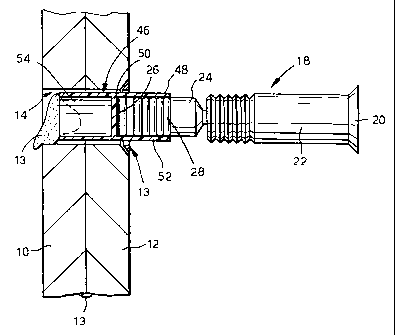Some of the information on this Web page has been provided by external sources. The Government of Canada is not responsible for the accuracy, reliability or currency of the information supplied by external sources. Users wishing to rely upon this information should consult directly with the source of the information. Content provided by external sources is not subject to official languages, privacy and accessibility requirements.
Any discrepancies in the text and image of the Claims and Abstract are due to differing posting times. Text of the Claims and Abstract are posted:
| (12) Patent: | (11) CA 2382710 |
|---|---|
| (54) English Title: | FASTENER PROTECTION |
| (54) French Title: | PROTECTION DE FIXATION |
| Status: | Expired and beyond the Period of Reversal |
| (51) International Patent Classification (IPC): |
|
|---|---|
| (72) Inventors : |
|
| (73) Owners : |
|
| (71) Applicants : |
|
| (74) Agent: | SMART & BIGGAR LP |
| (74) Associate agent: | |
| (45) Issued: | 2009-02-03 |
| (86) PCT Filing Date: | 2000-08-22 |
| (87) Open to Public Inspection: | 2001-03-08 |
| Examination requested: | 2005-08-04 |
| Availability of licence: | N/A |
| Dedicated to the Public: | N/A |
| (25) Language of filing: | English |
| Patent Cooperation Treaty (PCT): | Yes |
|---|---|
| (86) PCT Filing Number: | PCT/GB2000/003232 |
| (87) International Publication Number: | GB2000003232 |
| (85) National Entry: | 2002-02-22 |
| (30) Application Priority Data: | ||||||
|---|---|---|---|---|---|---|
|
The invention relates to a sheath (46) for protecting a fastener such as a pin-
tail locking bolt (18) as it is passed
through a passage (14), the sheath (46) defining a first hollow (52) at a
first end for receiving part (28) of the pin-tail locking bolt
(18) and a second hollow (54) at a second end suitable for collecting a
substance such as a sealant (13) in the passage (14).
La présente invention concerne une gaine (46) destinée à protéger une fixation, telle qu'un boulon de blocage à pivot (18), lorsqu'elle est passée à travers une ouverture (14), la gaine (46) définissant une première cavité (52), à une première extrémité, destinée à la partie recevante (28) du boulon de blocage à pivot (18), et une seconde cavité (54), à une seconde extrémité appropriée, destinée à réceptionner une substance, telle qu'un produit de scellement (13), dans l'ouverture (14).
Note: Claims are shown in the official language in which they were submitted.
Note: Descriptions are shown in the official language in which they were submitted.

2024-08-01:As part of the Next Generation Patents (NGP) transition, the Canadian Patents Database (CPD) now contains a more detailed Event History, which replicates the Event Log of our new back-office solution.
Please note that "Inactive:" events refers to events no longer in use in our new back-office solution.
For a clearer understanding of the status of the application/patent presented on this page, the site Disclaimer , as well as the definitions for Patent , Event History , Maintenance Fee and Payment History should be consulted.
| Description | Date |
|---|---|
| Time Limit for Reversal Expired | 2017-08-22 |
| Letter Sent | 2016-08-22 |
| Letter Sent | 2011-05-20 |
| Grant by Issuance | 2009-02-03 |
| Inactive: Cover page published | 2009-02-02 |
| Inactive: Final fee received | 2008-11-14 |
| Pre-grant | 2008-11-14 |
| Notice of Allowance is Issued | 2008-07-16 |
| Letter Sent | 2008-07-16 |
| Notice of Allowance is Issued | 2008-07-16 |
| Inactive: Approved for allowance (AFA) | 2008-05-13 |
| Amendment Received - Voluntary Amendment | 2008-01-03 |
| Inactive: S.30(2) Rules - Examiner requisition | 2007-07-03 |
| Amendment Received - Voluntary Amendment | 2005-09-30 |
| Letter Sent | 2005-08-26 |
| Request for Examination Requirements Determined Compliant | 2005-08-04 |
| All Requirements for Examination Determined Compliant | 2005-08-04 |
| Request for Examination Received | 2005-08-04 |
| Letter Sent | 2002-08-29 |
| Inactive: Cover page published | 2002-08-21 |
| Inactive: Notice - National entry - No RFE | 2002-08-15 |
| Letter Sent | 2002-08-15 |
| Application Received - PCT | 2002-05-30 |
| National Entry Requirements Determined Compliant | 2002-02-20 |
| Application Published (Open to Public Inspection) | 2001-03-08 |
There is no abandonment history.
The last payment was received on 2008-07-17
Note : If the full payment has not been received on or before the date indicated, a further fee may be required which may be one of the following
Patent fees are adjusted on the 1st of January every year. The amounts above are the current amounts if received by December 31 of the current year.
Please refer to the CIPO
Patent Fees
web page to see all current fee amounts.
Note: Records showing the ownership history in alphabetical order.
| Current Owners on Record |
|---|
| AIRBUS OPERATIONS LIMITED |
| Past Owners on Record |
|---|
| REGINALD DAVID PARSON |
| TERENCE PAUL ALLEN |